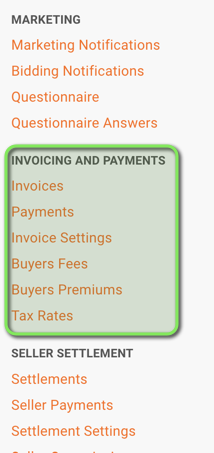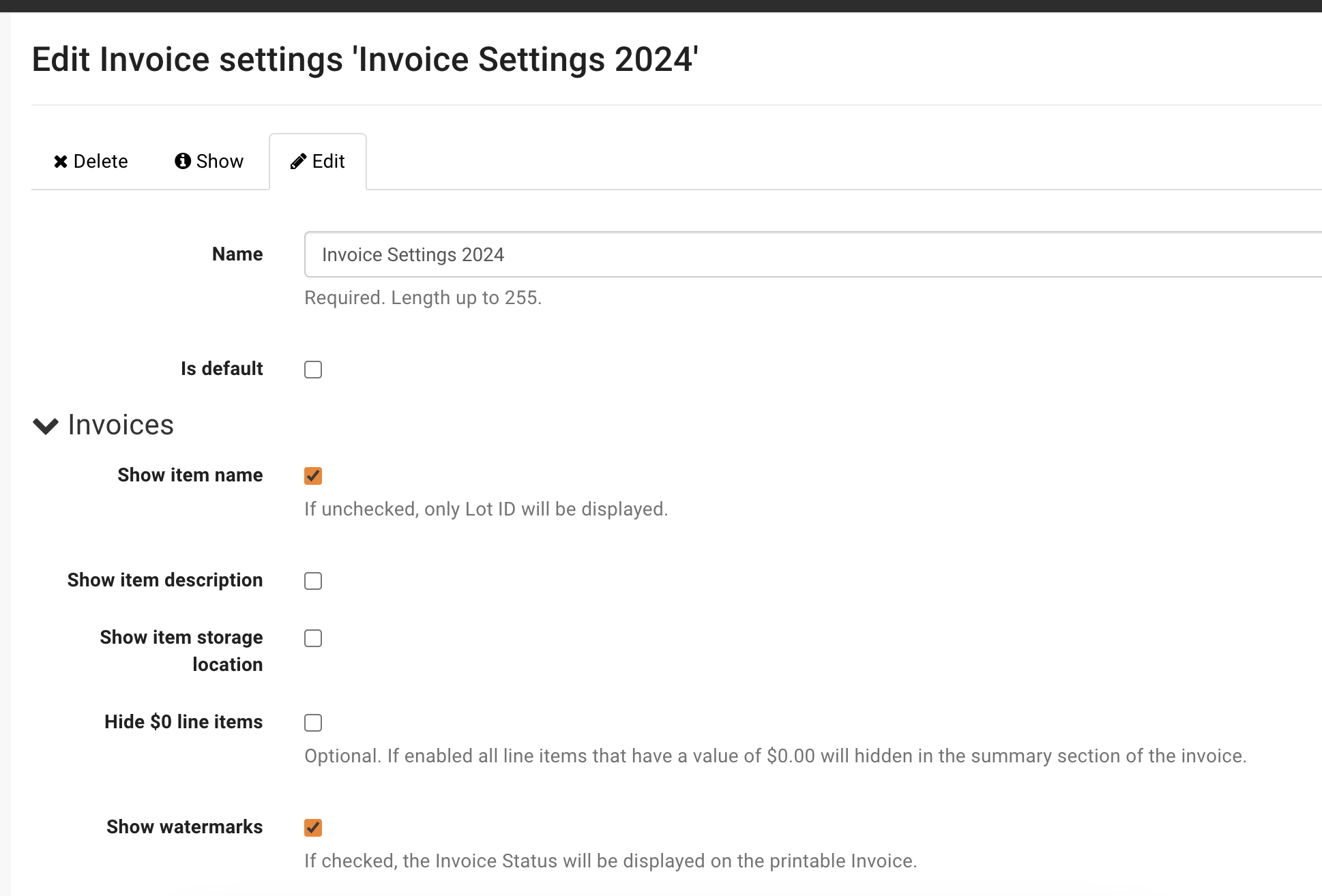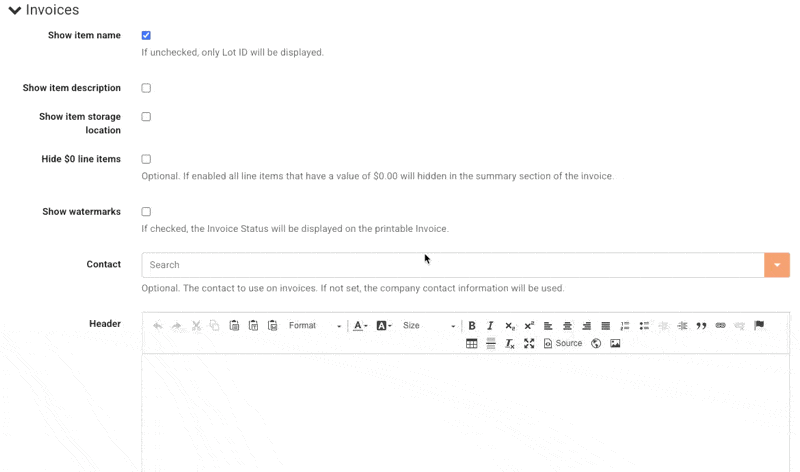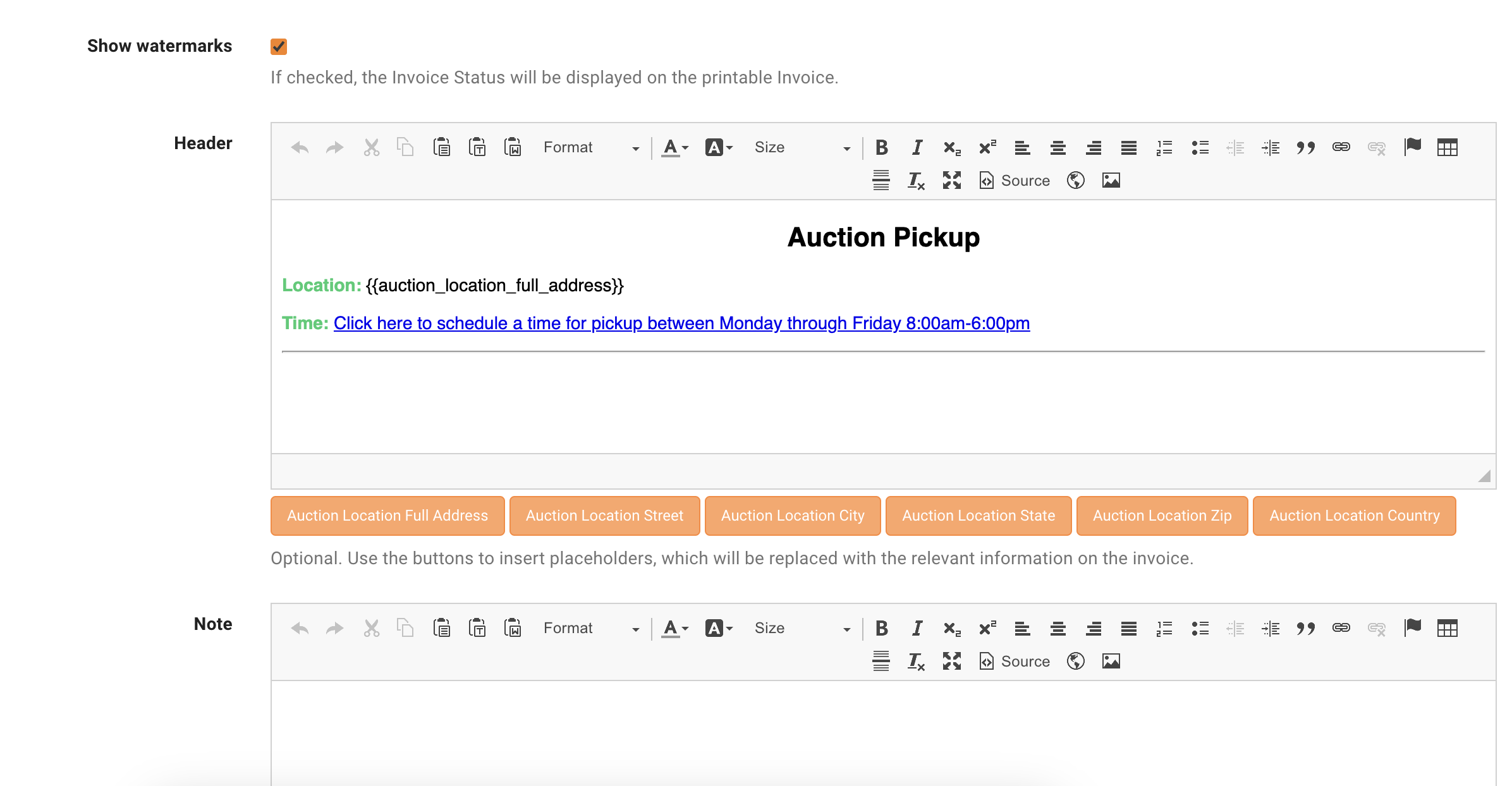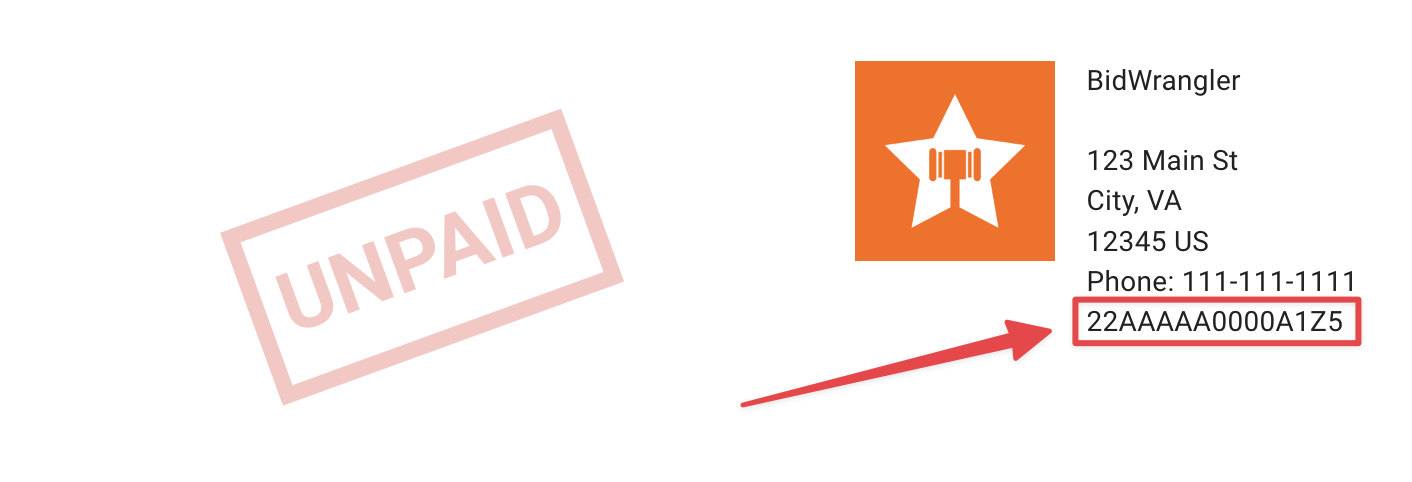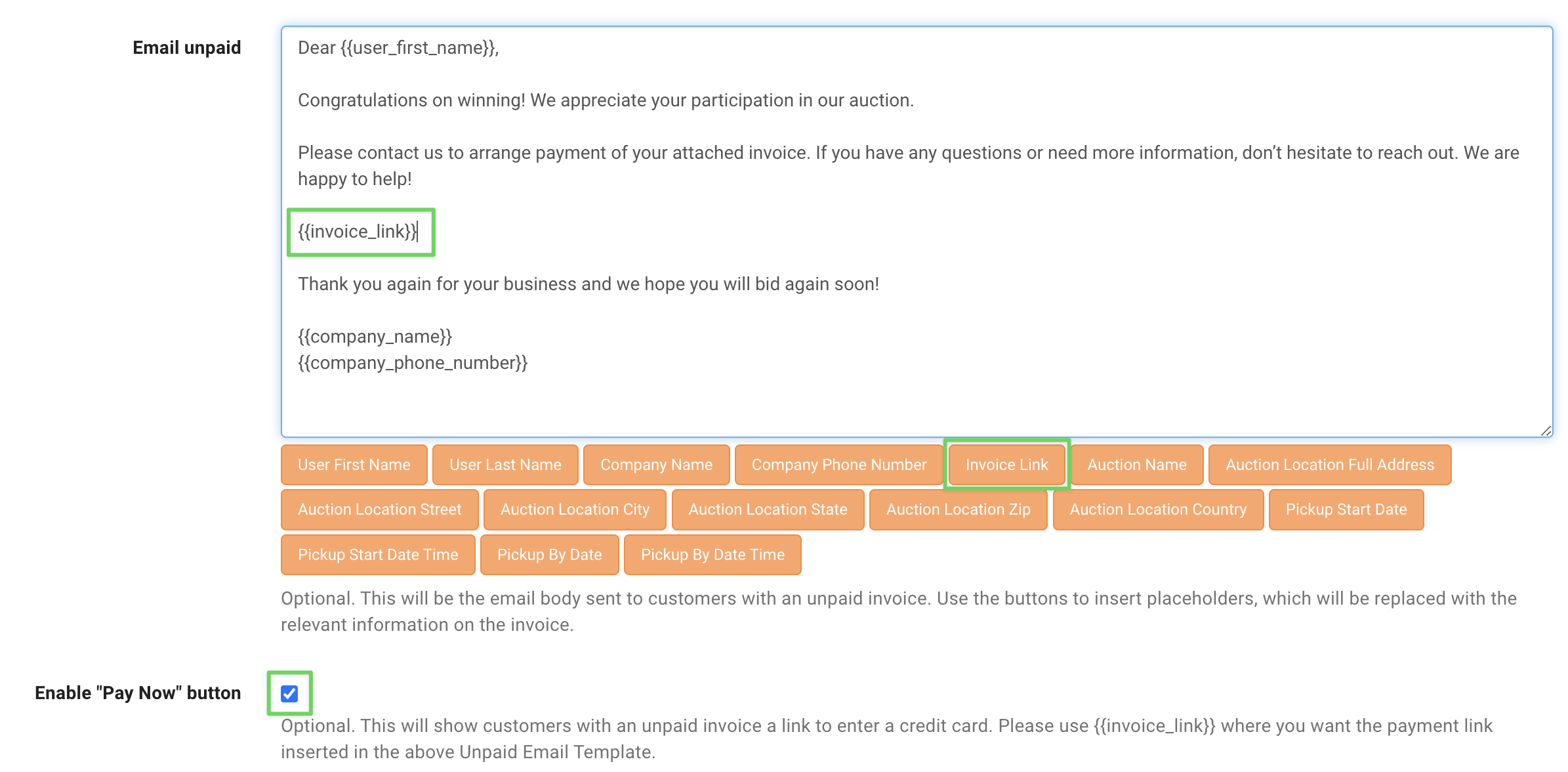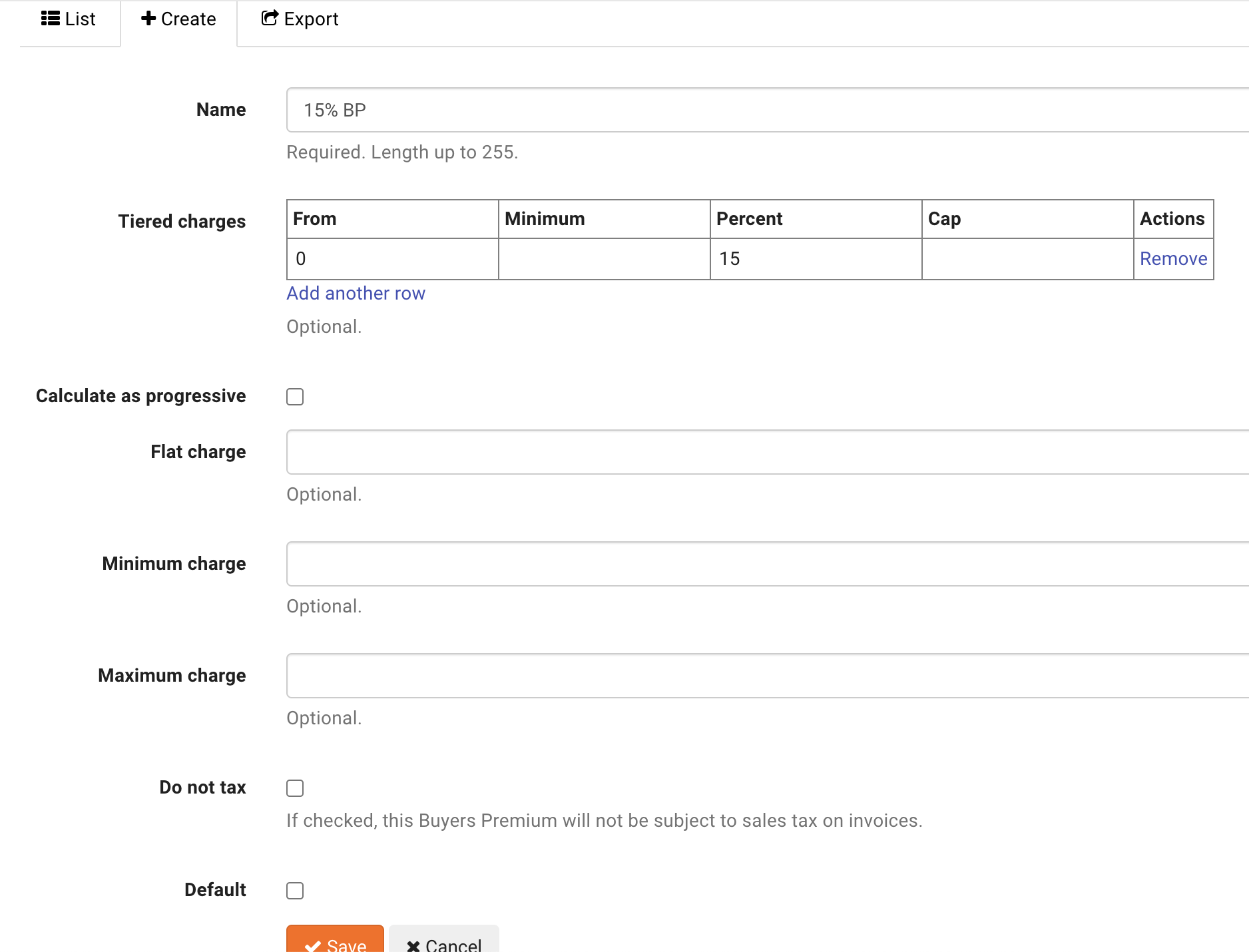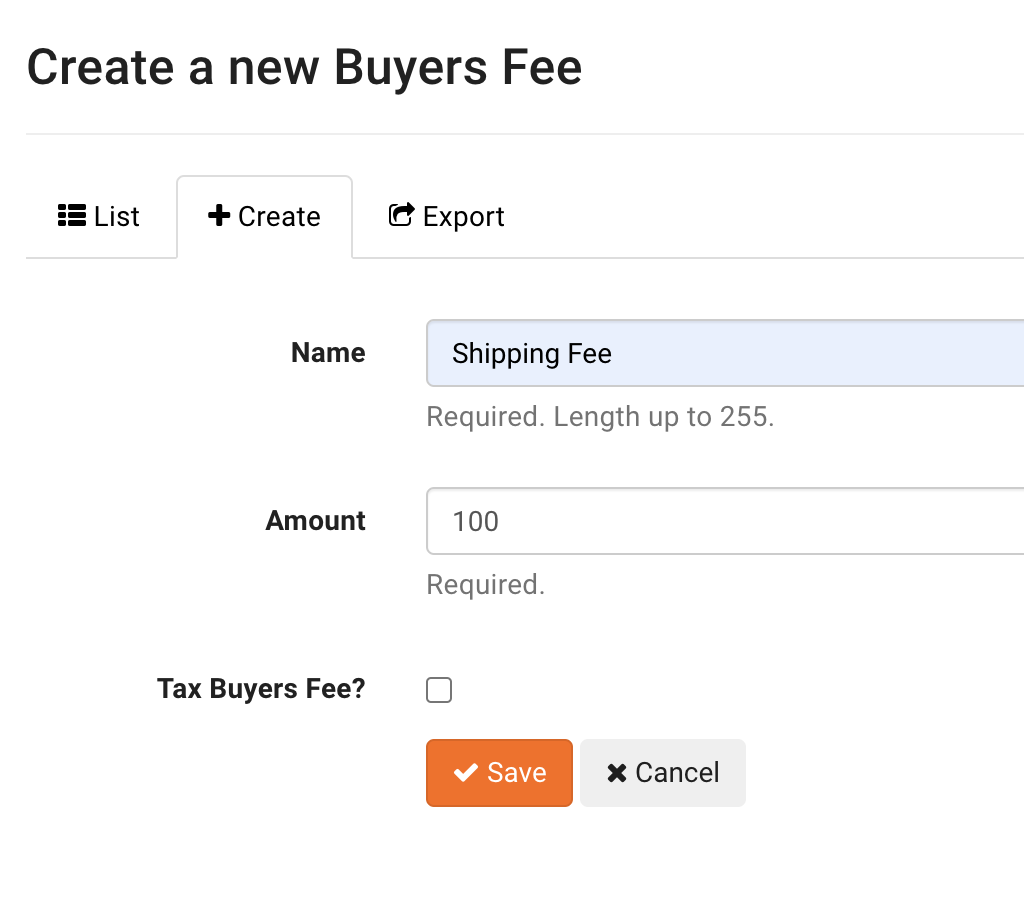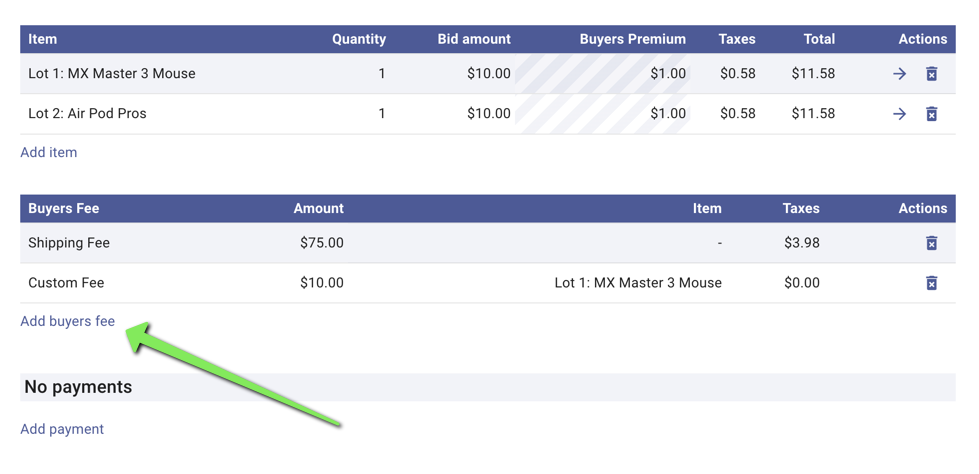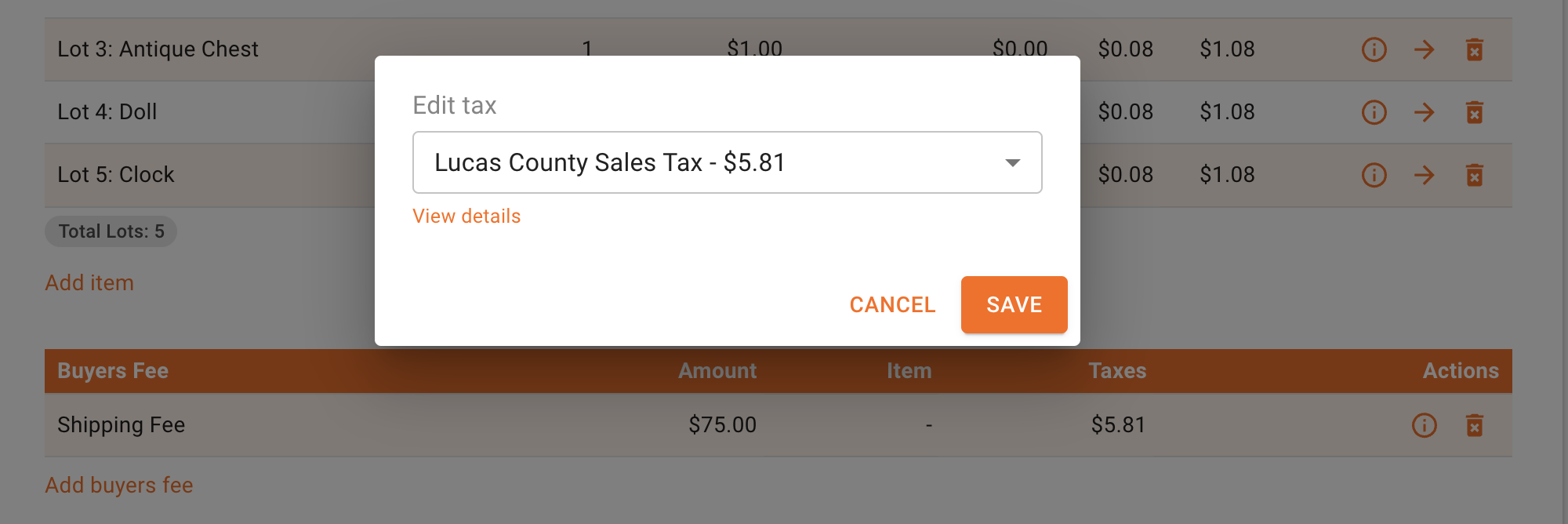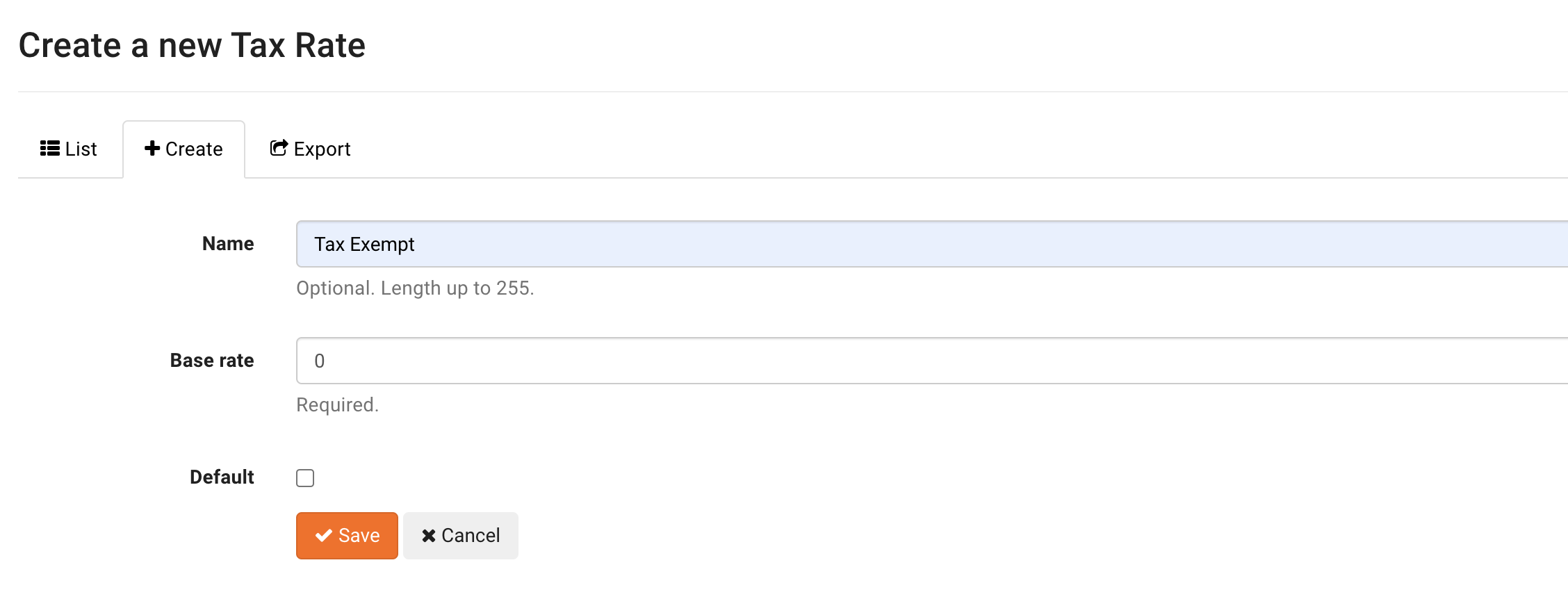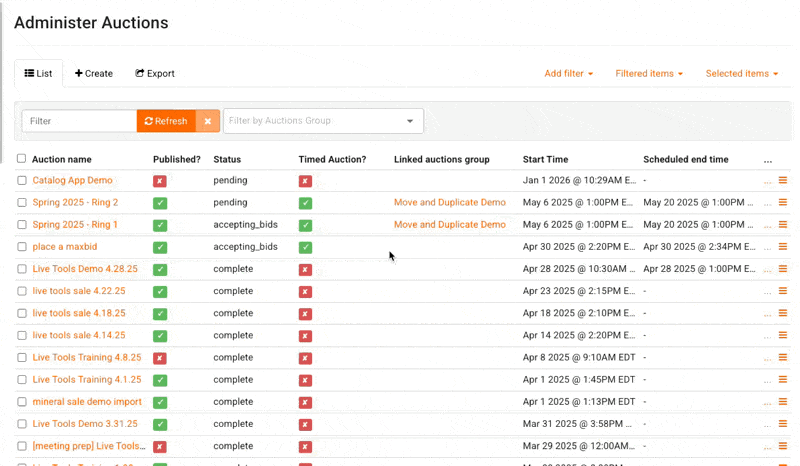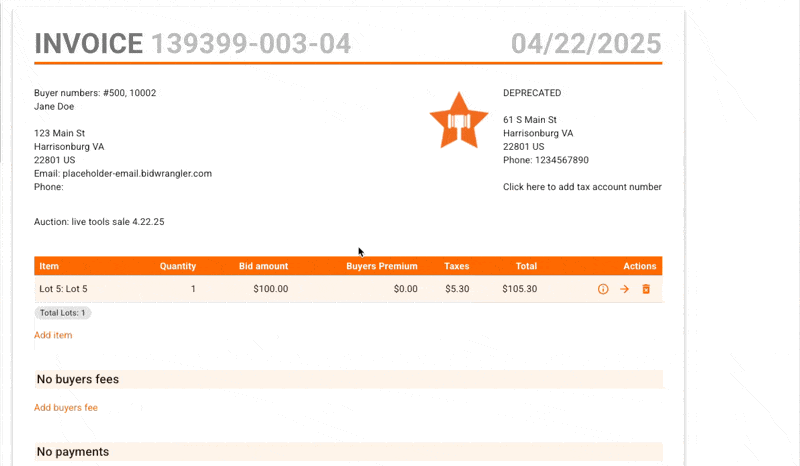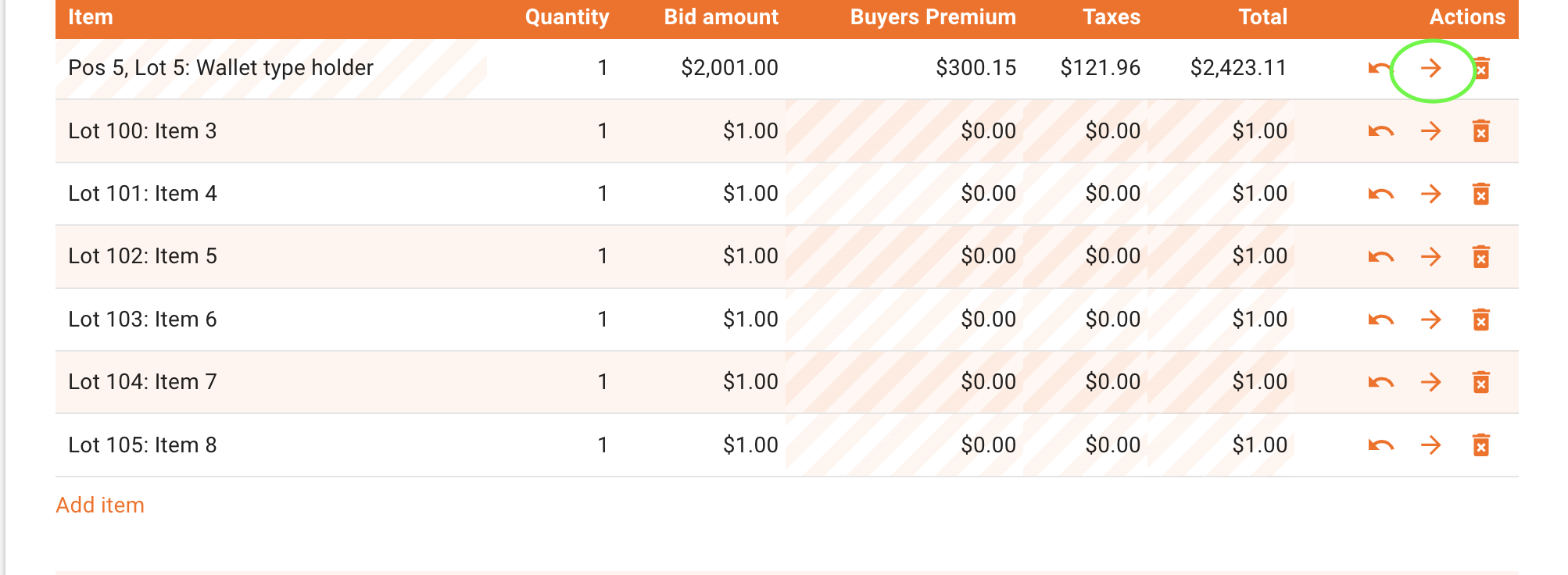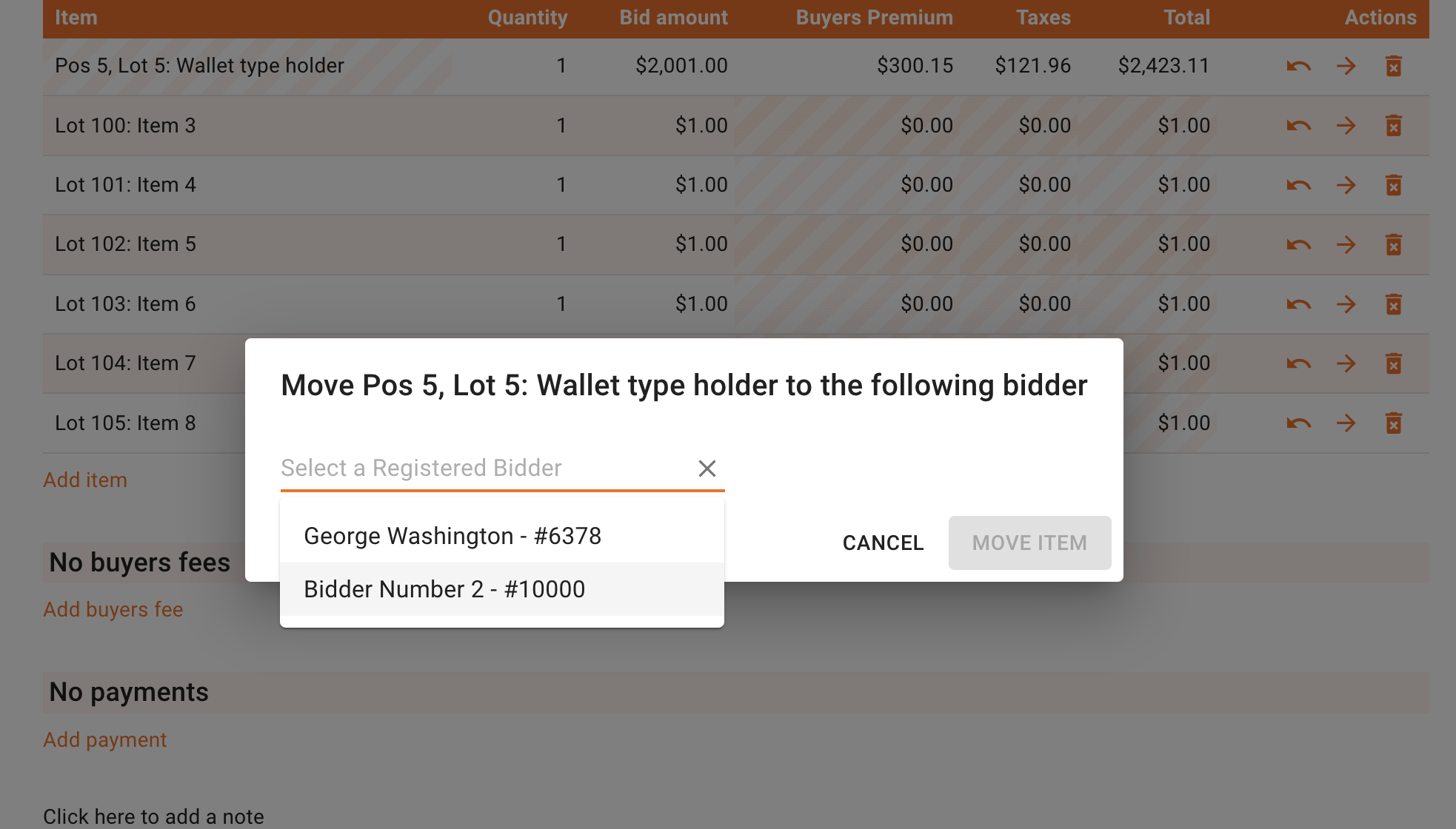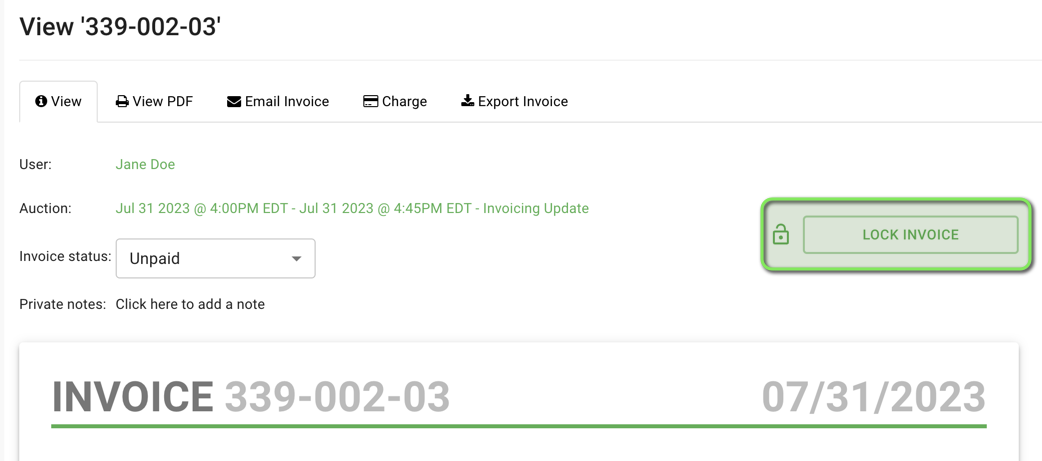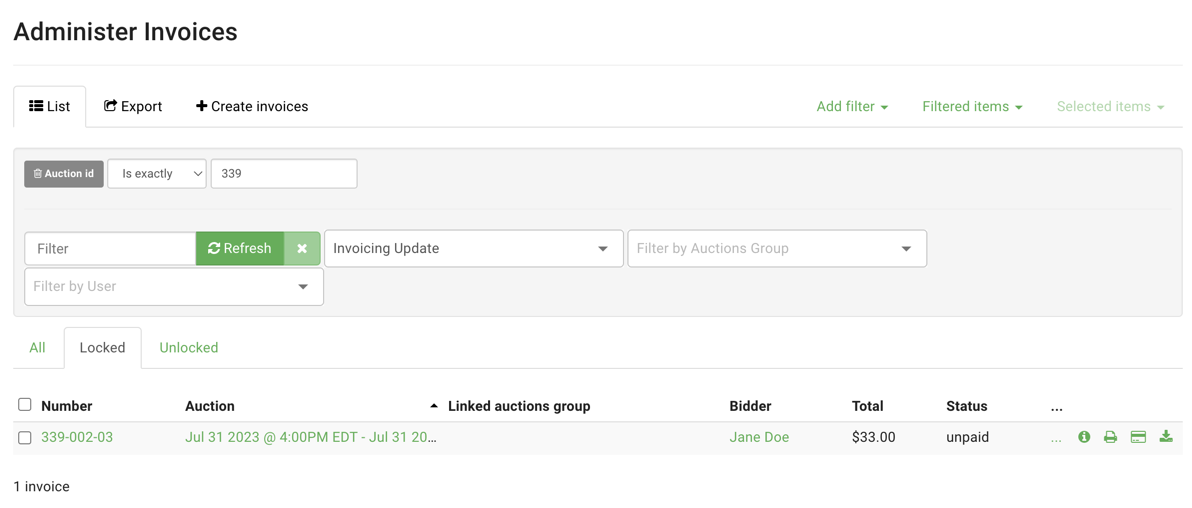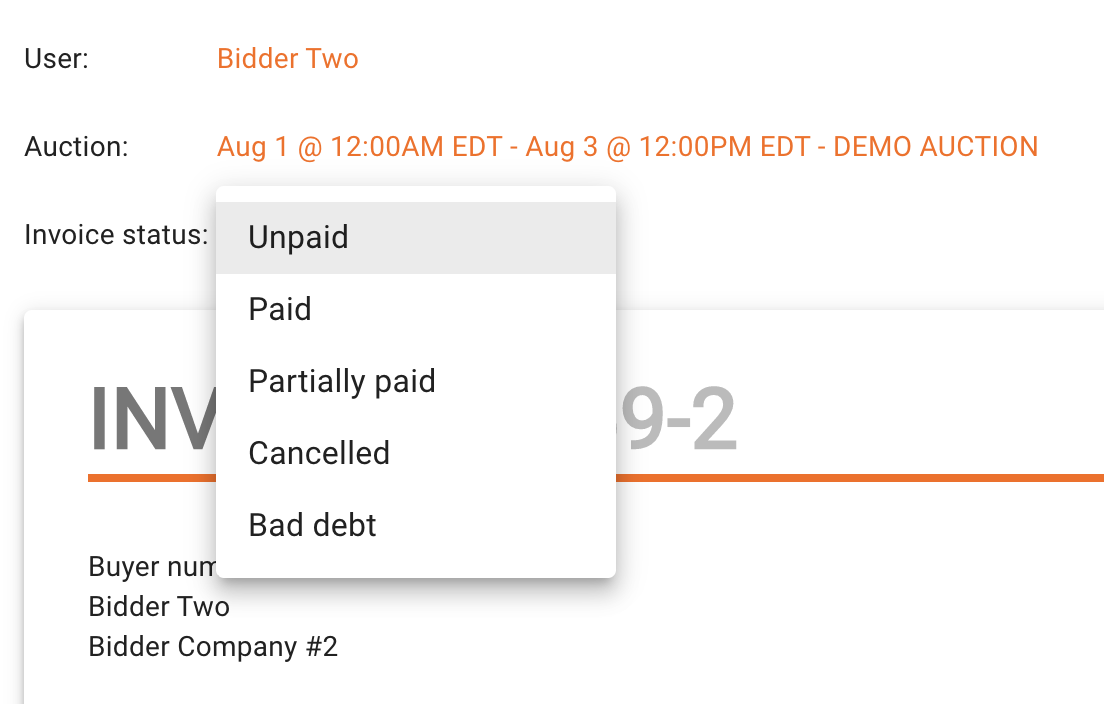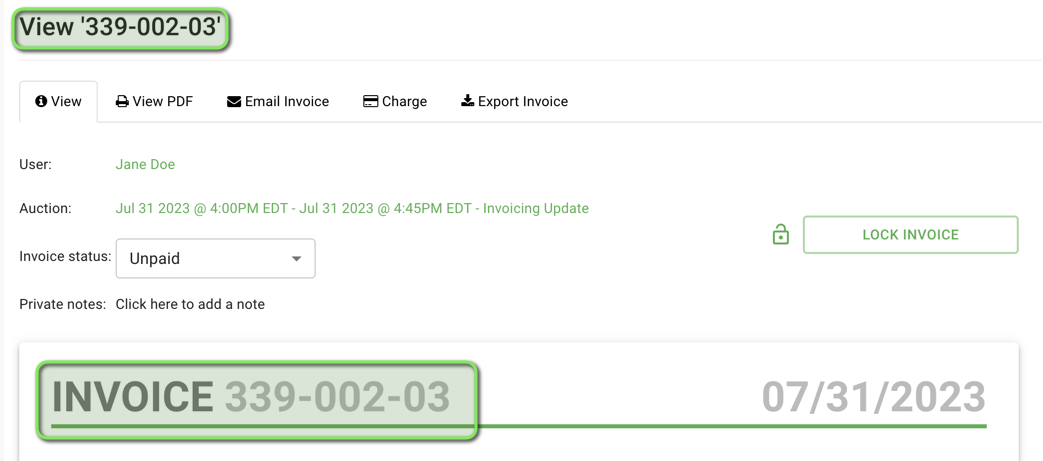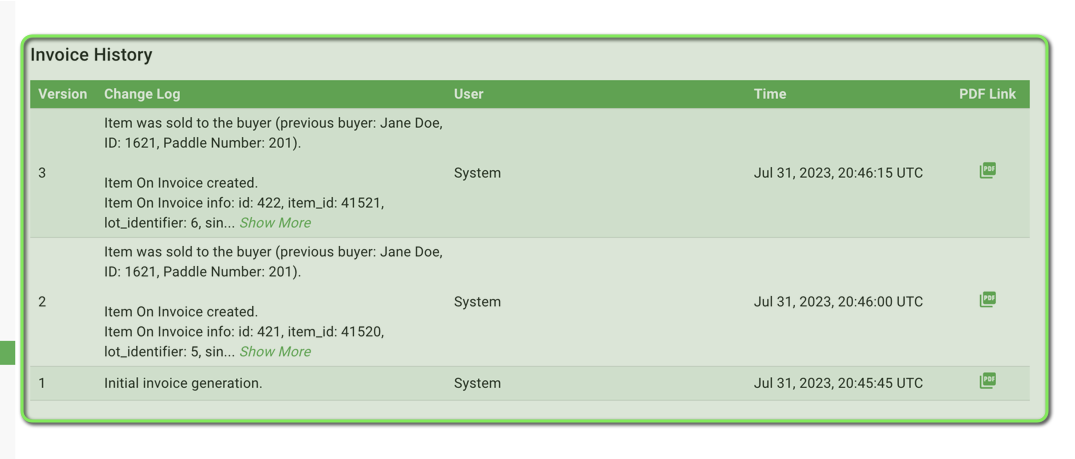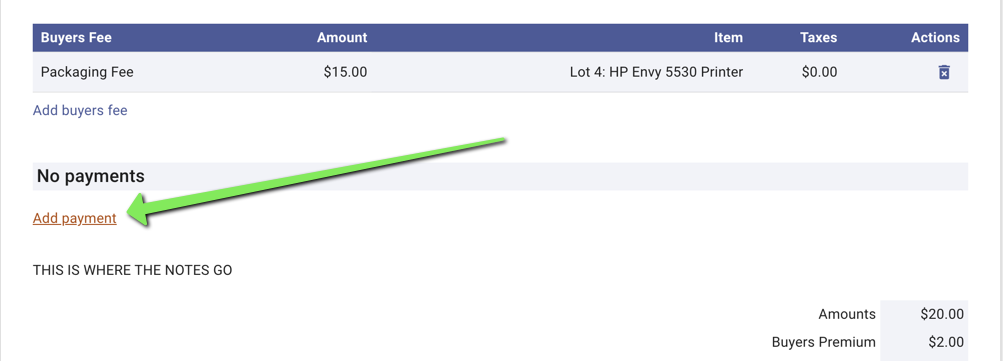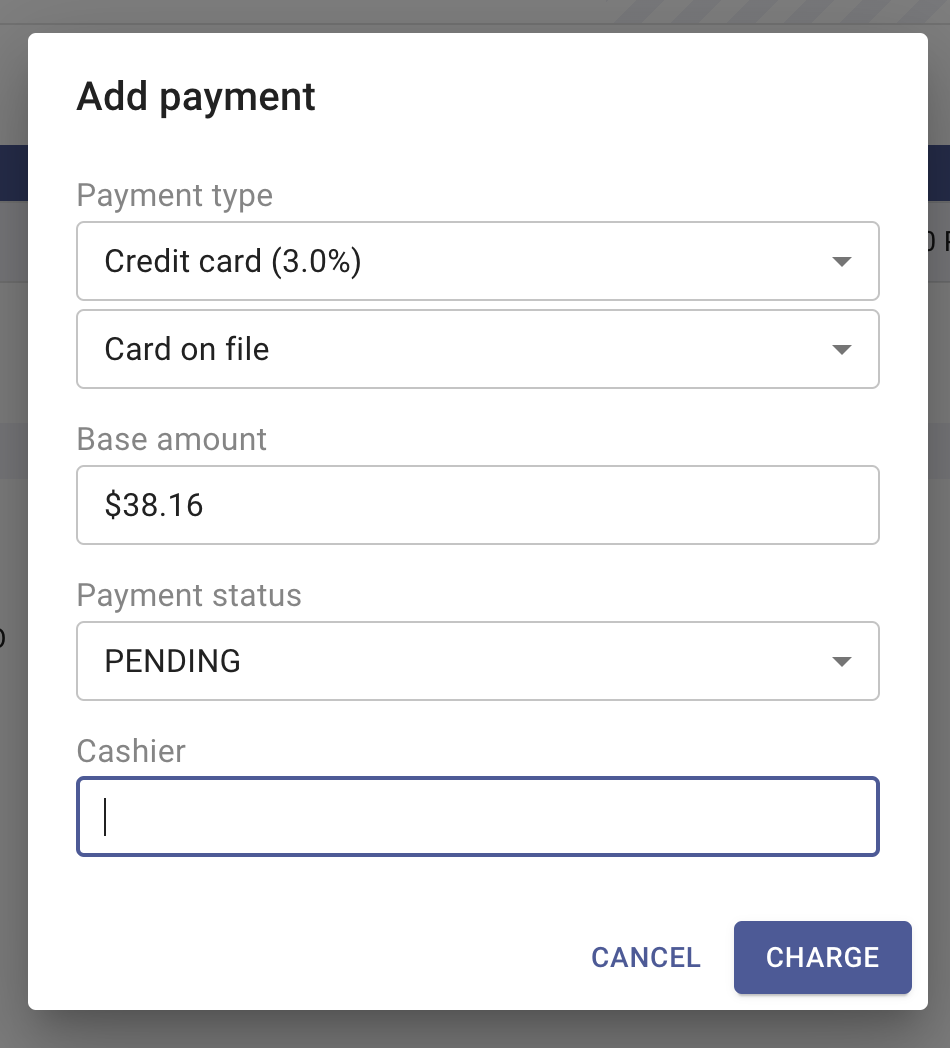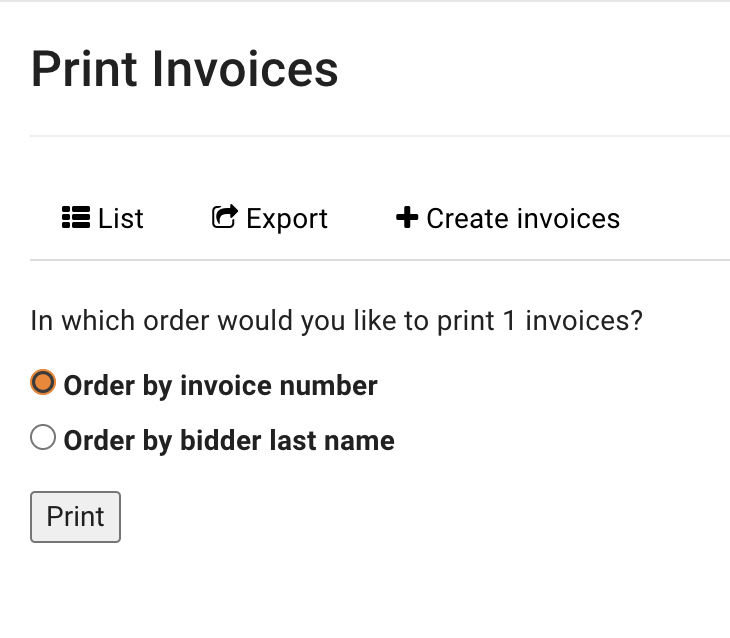Invoice Guide
This article will go over everything you need to know about invoices and how to get your invoices out to your customers upon completing an auction. Please review the table of contents below to learn about the many elements of BidWrangler's invoicing tools.
Invoice Setup
Before creating your invoices, make sure that the following settings are set up: Invoice Settings, Buyers Premiums, Buyers Fees, and Tax Rates.
These each have their own settings that need to be created before assigning them to default, the auction, individual items (excluding invoice settings), or even individual buyers (excluding invoice settings or buyer fees) so that they show up an auction's invoices.
All of these settings can be found under the INVOICING AND PAYMENTS menu in the Admin Portal.
Invoice Settings
Your invoice settings control not only the appearance of your invoices, but what email message is sent when charging/emailing invoices. Additionally, this is where we can enable the ability for bidders to pay their invoices online via the Pay Now Button.
On the Invoice Settings screen, click "Create" to create new settings.
Invoice Settings Name and Features
The name field will be used when identifying and assigning the settings. Most invoice settings have auction-specific information, so you will want to name it according to the applicable auction. If your settings will be set as default, a more generic name may be used.
Invoice Settings include checkboxes for enabling a variety of fields including item name, description, item storage location, hide $0 line items, and paid or unpaid watermarks.
Invoice Settings "Company" field allows you to create new company contacts to be used on invoices. Instead of using the default contact information in your Company Settings, you can create new contacts for other office locations or affiliates here.
Invoice Header, Note, and Footer
The Header, Note, and Footer fields allow you to control what additional information is presented on each invoice for the auction with these settings assigned. Location Variable Buttons allow an admin to place their cursor in the field then quickly add a variable that will auto-populate location data from the auction. As of October 2024, these text fields have been updated with basic HTML text formatting similar to what is available for auction descriptions.
Tax Account Number
The Tax Account Number field is an optional field that allows a company to display alphanumerical data alongside their company info on all invoices. This is intended for companies in areas where company tax identification numbers must be present on customer-facing invoices.
Example of a GST number entered in the Invoice Settings "Tax Account Number" field:
Email Paid and Unpaid
The Email Paid and Unpaid fields control the emails that are sent based on the status of their invoices. Webpage URLs can be added here that will automatically become hyperlinks in the email messages. A variety of variables are available for adding to the emails that will automatically pull from user, company, or auction data.
What are variables?
Variables can added to invoices and emails. Place your cursor in the field where you would like the variable placed, then click the orange-colored button for the variable you would like to add. It should appear with double brackets like "{{user_first_name}}," which you can cut and paste to move anywhere else you like.
Bidders can pay for their invoices through the Admin Portal by enabling the "Pay Now" button and adding the invoice link variable to the Email Unpaid field as shown below. Click here to learn more on how to use this feature.
After saving your invoice settings, they need to be assigned to an auction within the auction's settings. Click on the dropdown arrow or use the search field to find the invoice settings you would like to apply, then save the auction.
Buyers Premiums
Buyers premiums are found under the INVOICING AND PAYMENTS menu in the Admin Portal. You will land on a page that lists every buyers premium that has been created and saved. Click on the create tab at the top of the page to create a new one. Below is a screenshot of the buyers premium create screen:
The settings here can be customized in many different ways. For a simple percent-based buyers premium, name it, fill in what percent you would like within tiered charges under the percent column (make sure to exclude the % sign as shown above), then Save. If you have any questions about these settings, please email us at helpdesk@bidwrangler.com.
Buyers premiums can be set to default from their edit screen, assigned to a specific auction, item, or even a specific user.
Click here for more details on Buyers Premiums.
Buyers Fees
Buyer fees are found under the INVOICING AND PAYMENTS menu. We provide the option to name it, set a base amount, and the choice to apply an assigned tax rate to the fee.
These can be assigned to the auction level, or even individually added on specific invoices. On specific invoices, you have the option to add pre-made fees or custom fees (instead of creating them from the Buyers Fee page) that can be named and assigned to a specific item as shown below:
If the Buyer's Fee had "Tax Buyer's Fee" enabled, it will automatically assume the tax rate applied to the auction. If you need to change the tax rate on any invoice, click on the tax rate under the Taxes column to adjust the tax rate to another created tax rate, or a custom amount.
Tax Rates
Tax Rates are found under the INVOICING AND PAYMENTS menu and look like the screenshot below when creating a new tax rate:
Tax rates can be set to default from their edit screen, assigned to an auction, a specific item, or even a user (for assigning someone tax-exempt).
Credit Card and Point of Sale Convenience Fees
Credit Card and Point of Sale Convenience Fees allow auction companies to add an additional percent to charge buyers paying via credit card and/or point of sale payment methods. This fee can be configured independently for credit card and point of sale payment methods
Like other settings, this can be set via Company level {Company > Edit > API Integrations} then overwritten if needed in Auction Settings
Taxing Convenience Fees
In some locations, it is required to relay the buyer's sales tax to the credit card and point of sale convenience fees as well. This can be enabled at the Company and Auction levels via the "Tax Payment Fees" checkbox. The tax rate applied is pulled from the tax rate assigned to the auction settings.
Invoice Creation and Editing
To create your invoices after an auction is over, navigate to the Invoices page in the Admin Portal. All generated invoices can be found on this screen. Click on Create Invoices, then select the auction for the invoices you want to generated.
Automatic Invoice Generation
In your Company Settings, or for any specific auction, automatic invoice generation can be enabled (or disabled) so that invoices don't need to be created manually. Click here for that article.
Editing Invoices
Locating Invoices
To start working with the newly generated invoices, filter for that auction by typing/finding the auction in the "Filter by Auction dropdown" or quickly by loading the auction filter automatically via Auctions > Edit > Invoices as shown below. Only the invoices from that auction will appear.
Another way to filter for an auction's invoices is to click on Add filter > Auction ID > set the filter to "is exactly" > place the Auction ID and click on "Refresh" or use your Enter key.
Editing Fields On Invoices
Many of the fields on invoices can be edited and manipulated by clicking on the desired field. Adjusting bid amounts will edit that bid on the Online Clerking Screen and Bids screen, updating a tax rate on an individual item will do the same in its' settings, and so on.
Moving Items from One Invoice to Another
Lots can be moved from one unpaid invoice to another by clicking on the arrow icon to the right of the desired item:
Next, select any registered bidder {in that auction} to move/reclerk the item to. If the bidder you would like to sell the item to is not registered in this particular sale, they will need to be registered first.
If the bidder that the item is being moved to does not have an invoice yet, and Automatic Invoice Creation is not enabled for this auction, invoices for this auction will need to be created again in order for the new bidder's invoice to appear.
Reclerking Items
While items can be reclerked or moved to another buyer via individual Invoice screens, there are a couple of other options as well. Learn more about reclerking or reselling items here.
Locking and Unlocking Invoices
To prevent unintentional altering of invoices, invoices now lock when a payment has been made. You can manually lock or unlock an individual invoice from the invoice View screen.
When an invoice is locked, only a payment can be added. To update a locked invoice, you may either unlock and make the necessary changes, or make the changes, then unlock after the fact for the changes automatically show up on the invoice.
The Administer Invoices screen has new categories to easily separate Locked and Unlocked invoices from All.
Invoice Status
The Invoice statuses change automatically between unpaid, partially paid, and paid according to payments, but you may want to change them manually for clerical reasons. To update the payment status of the Invoice, simply mark it from the status dropdown here -
(Note - Deleting a payment in BidWrangler — although it will readjust the balance of an invoice — does not refund the payment. Refunds should be processed through your payment gateway.)
The "Cancelled" Status will automatically no-sale all items on that invoice. If the items have not been sold to another bidder, changing the status back to Unpaid would reassign those items to the invoice.
"Bad Debt" is another option for clerically marking invoices.
Invoice Versions
Our invoices now display every change that has been made to them. The invoice number will update the version number (the last two digits) as changes are made.
Every version of an invoice will be saved in the Invoice History, which is located below the invoice. For every version, you will find what change has been made, who made the change, and what time it was changed (in UTC time). We also allow you to download a PDF of any one of the versions.
Charging and Emailing Invoices
Charging Cards
From the Invoices screen, you can charge or email all or specific invoices. Charging invoices sends an email according to whether the payment was successful or not. This email can be customized via the invoice settings. You may also email [and not charge] invoices in the same way.
Click here for more details regarding charging cards on file.
Click here for more details regarding emailing invoices or settlements.
Alternative Payments
Within a specific invoice, you can run a card, alternative one-time card, or clerically mark other forms of payment: Cash, Check, Wire Transfer, or Custom by clicking Add payment:
When charging the card on file from this screen, select PENDING to charge the card. Completed or Failed are used for manually marking an invoice, and is usually for those charging cards in payment processors we don't support:
Printing Invoices
In the same way that you can charge/email invoices by filtering [Filtered items] or selecting invoices [Selected items], the same can be done to print invoices. Once you click on print from either dropdown, you then get the option to print in order of invoice number or bidder last name:
Then, click on the printer icon [top right] on the following screen:
Pay Now Feature
Enable a Pay Now button that appears on your unpaid invoice emails. This is set within Invoice Settings. Click here for our support article on the topic.
Troubleshooting
Below are a series of common invoice problems and answers:
Missing Buyers Premium, Tax Rate
If you're missing buyers premiums or tax rates on your invoices, check to see if the auction's settings have them assigned. If specific items or buyers need a premium or tax rate to overwrite, see if they are assigned to that item or buyer. Regenerate invoices [not create] to update these changes.
Missing Buyers Fees
If you are missing a buyers fee that should be on ALL invoices, check to see if it is applied to the auction's settings, then regenerate. If there are fees for specific items, make sure the fee is applied to those specific items in their settings, then regenerate. Custom and pre-made fees can be applied directly to specific invoices as well.
Missing Credit Card Convenience Fee
If you don't see credit card convenience fees being applied on invoices before payment, this is normal. Convenience fees don't show up until a credit card is charged (make sure these fees are disclosed in your terms and conditions). Credit Card Convenience Fees are assigned in your Company Settings (this fee would be applied to any credit or debit card payment).
I need to add additional information on an invoice.
If you need additional information in your header, notes, or footer sections on your invoice, you can do this for ALL invoices in an auction by updating the Invoice Settings. Regenerate afterwards. Additionally, you can edit any of these sections on a specific invoice by clicking on the field, editing, then saving.
I need to add an item to an invoice.
If you need to create a new item that's not currently in your catalog, click on Add Item underneath the rows of items on a specific invoice.
I can't move an item from one invoice to another.
If you are having trouble moving items between invoices, make sure that the bidder for the invoice has a user account. Then, make sure that the bidder is registered for that specific auction. You cannot move items to unregistered bidders.
I moved an item from one invoice to another, but the item isn't showing up.
Click regenerate on the invoice where the item should be to update it.
I moved an item from one invoice to another, but I can't find the invoice.
If the bidder did not previously win any items before moving items, they have not had an invoice created. Recreate [not regenerate] the auction's invoices to create an invoice for the bidder.
How do I remove an item from an invoice?
Find the item on the invoice you wish to remove, then click on the trashcan on the far right of the item's row.
I need to refund an invoice.
To refund an invoice, their payment will need to be voided or refunded in STRIPE or AUTHORIZE.NET first. Then, go back to that invoice in BidWrangler, click into the invoice, scroll down to their credit card payment and click on the trashcan to delete. This will automatically change the status of the invoice to unpaid.
Example Workflow
Below, are a series of steps that could be followed in order to produce and send out invoices upon the completion of an auction:
Navigate to the Invoices page under INVOICING AND PAYMENTS within the Admin Portal
Click on Create Invoices
Select the Auction or Linked Auctions Group, then Create
Filter for the auction's invoices by recent auction or by adding a filter for the auction ID
Check to see if the invoices look correct by clicking into various invoices (i.e. Are there buyers premiums applied? Tax rates? Should there be any addition information in the header, notes, or footer via the Invoice Settings? Are there any specific buyers/invoices that need additional buyers fees or notes?)
Does the Pay Now Feature need to be enabled? (enabled in Invoice Settings and applied in the auction's settings)
Is there a Credit Card Convenience Fee (%)? (check your Company Settings)
If invoices and all settings look right, you can charge and/or email invoices by either:
Filter for the auction. Click on Filtered Invoices, then Charge or Email [ALL] invoices.
Filter for the auction. Click on the top-most checkbox to select all invoices on that page. DESELECT any invoices you don't wish to charge/email, then click on Selected Invoices. Charge or Email [SELECTED] invoices for that page. Repeat for subsequent pages if any

